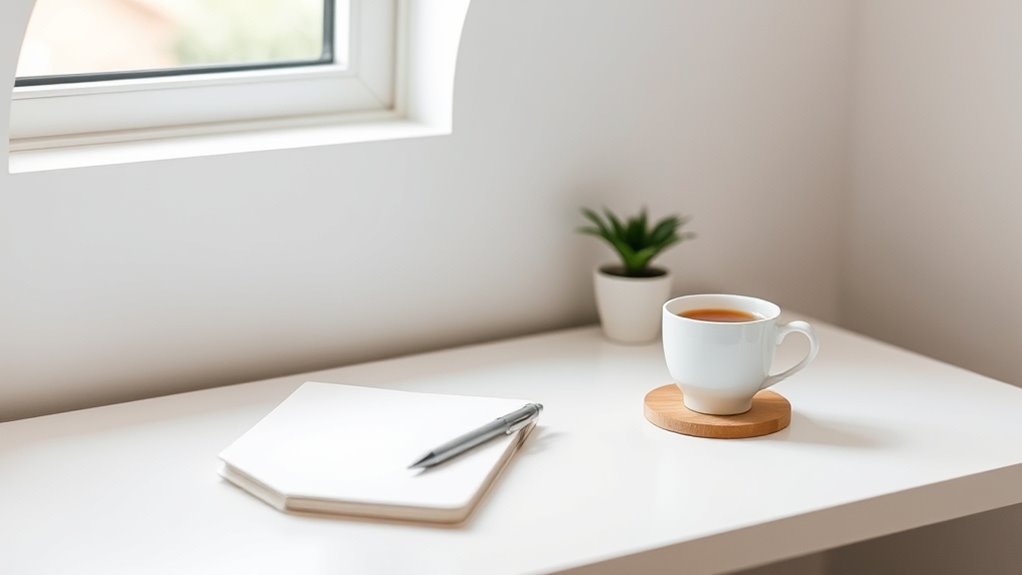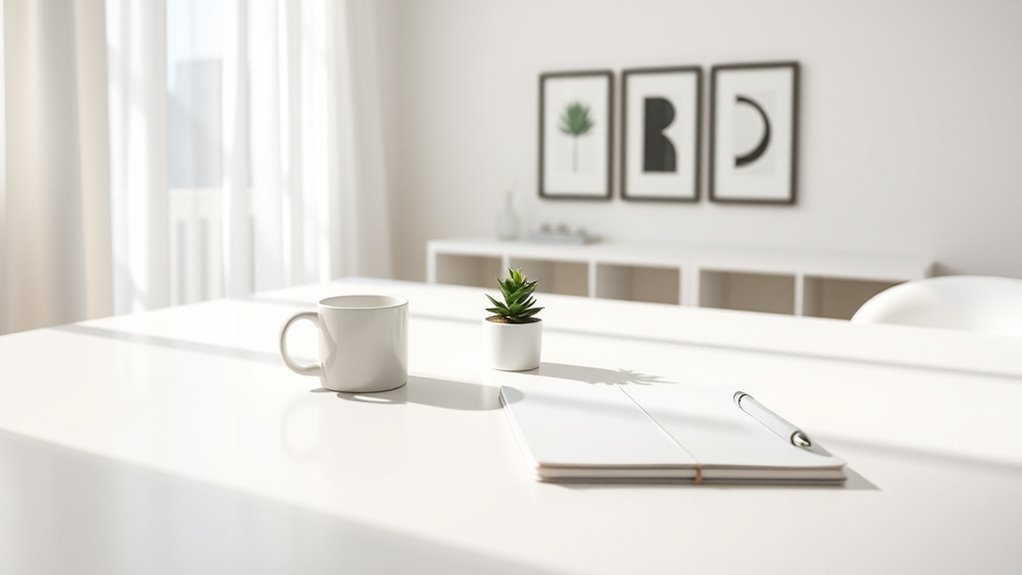The Micro‑Minimalism Challenge invites you to make small, intentional tweaks that add up to a simpler, calmer life. Focus on decluttering just one area, adopt mindful shopping habits, or organize your digital life. Incorporate tiny changes into your daily routines to reduce overwhelm and increase clarity. These little steps foster greater mindfulness, mental space, and fulfillment over time. Stick with it, and you’ll discover how these manageable shifts can transform your lifestyle and bring more joy.
Key Takeaways
- Implement small decluttering sessions in specific areas to create a more manageable, peaceful environment.
- Make intentional purchasing choices by practicing mindfulness and questioning the true value of items.
- Simplify your digital life by unsubscribing, deleting distractions, and organizing files for easier access.
- Incorporate tiny routine tweaks that gradually align your daily habits with a minimalist, intentional lifestyle.
- Recognize that small, consistent changes promote mental clarity, reduce overwhelm, and foster fulfillment over time.

Ever wondered if you could simplify your life by focusing on just a few essential possessions? The micro-minimalism challenge is all about making tiny tweaks that add up to a more intentional way of living. Instead of overhauling your entire space or mindset overnight, you focus on small, manageable changes that promote clutter reduction and help you embrace intentional living. These little adjustments aren’t meant to be overwhelming—they’re designed to fit into your daily routine and gradually reshape how you see and interact with your possessions.
Start by choosing one area of your home to declutter. Maybe it’s your desk drawer or your closet shelf. The goal is to remove anything that doesn’t serve a clear purpose or bring you genuine joy. This practice of clutter reduction isn’t about perfection; it’s about creating space for what truly matters. As you let go of unnecessary items, you’ll notice how much lighter and more manageable your environment feels. It’s amazing how just a few small changes can bring a sense of clarity and calmness into your life.
Choose one area to declutter and create space for what truly matters.
Next, consider your everyday routines. Are there small habits you can tweak to foster more intentional living? For example, before you make a purchase, pause and ask yourself if it’s truly necessary. Will this item add value to your life, or is it just filling a temporary gap? This simple act of mindfulness helps you avoid impulsive buying and emphasizes quality over quantity. Over time, this approach encourages you to become more intentional with your possessions and your time, reinforcing that you don’t need a lot to be fulfilled.
Another way to incorporate micro-minimalism is by simplifying your digital life. Unsubscribe from newsletters you no longer read, delete apps that distract you, or organize your files. These small digital declutters free up mental space and make your daily routines more efficient. As you clear physical and digital clutter, you create room for more meaningful experiences and focus on what genuinely aligns with your values.
Frequently Asked Questions
How Do I Start Micro-Minimalism if I Feel Overwhelmed?
When you feel overwhelmed starting micro-minimalism, focus on a mindset shift. Break it into small steps—you don’t need to overhaul everything at once. Begin with one area, like decluttering a drawer or reducing notifications, and celebrate each win. Over time, these tiny tweaks build momentum, making the process feel more manageable. Remember, progress is about consistency, not perfection, so be patient and trust the journey.
What Are Some Common Mistakes to Avoid During the Challenge?
You might think avoiding mistakes is a breeze, but perfectionism pitfalls and impulse clutter can trip you up. Don’t aim for perfection; it’s a trap that leads to overwhelm. Resist impulse clutter by pausing before adding items or commitments. Focus on small, consistent steps instead of big wins. Remember, progress beats perfection. Keep your goals realistic, and don’t let fear of mistakes stop you from enjoying the journey.
How Can Micro-Minimalism Improve My Mental Health?
Micro-minimalism can boost your mental health by encouraging mindfulness practices that keep you present and focused. As you simplify your surroundings, you reduce overwhelm and create space for emotional resilience. By decluttering both physically and mentally, you gain clarity and calmness, making it easier to handle stress. This intentional approach helps you build a stronger, more balanced mindset, fostering overall well-being and a greater sense of control in your life.
Is Micro-Minimalism Suitable for Families With Children?
You might find micro-minimalism suitable for your family with children by using child-friendly organizing techniques. It encourages small, manageable decluttering steps that fit your kids’ routines, making the process less overwhelming. Family decluttering strategies like involving your children, setting simple goals, and creating designated storage help instill organization habits while keeping your space functional and calm. This approach fosters a peaceful environment for everyone without adding stress.
How Long Does It Typically Take to See Results?
At first, you might feel impatient, wondering how long real change takes. Results from tiny lifestyle changes and habit formation often appear in just a few weeks, but consistency is key. While some notice improvements in clarity and calmness within a month, others may take longer. Stay committed, and you’ll find that small tweaks gradually transform your daily life into a simpler, more intentional experience.
Conclusion
By embracing these tiny tweaks, you’re carving out a clearer, calmer space in your life—like peeling away layers of clutter to reveal your true self. Micro-minimalism isn’t about drastic change; it’s about small, steady steps that add up to a more intentional, joyful existence. So, take a deep breath, start with one simple change today, and watch how your life transforms into a peaceful garden, flourishing with simplicity and purpose.









